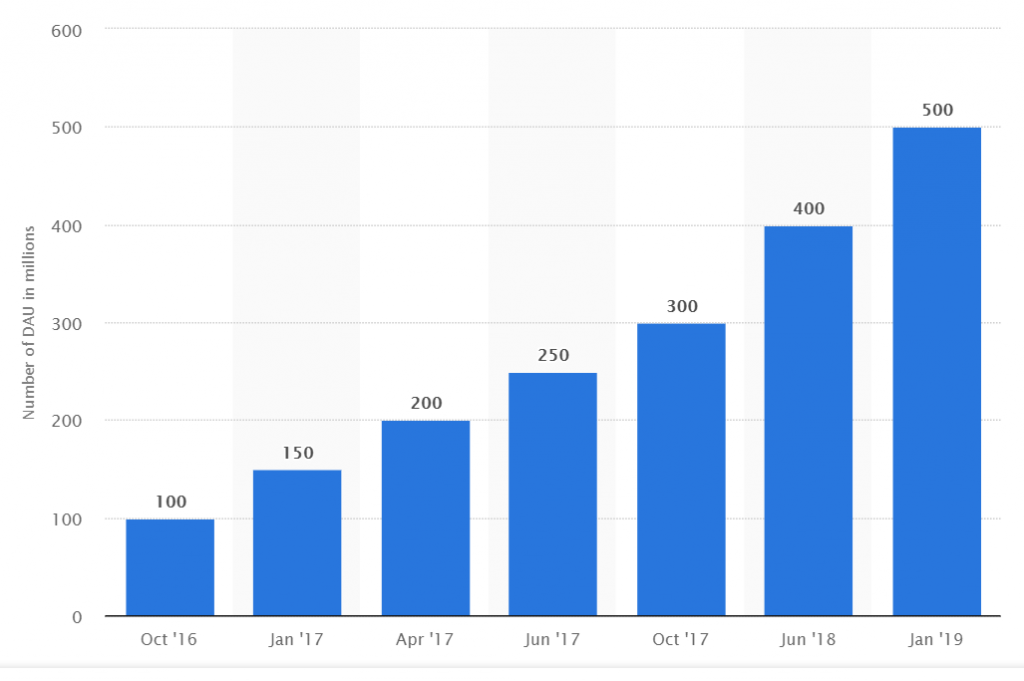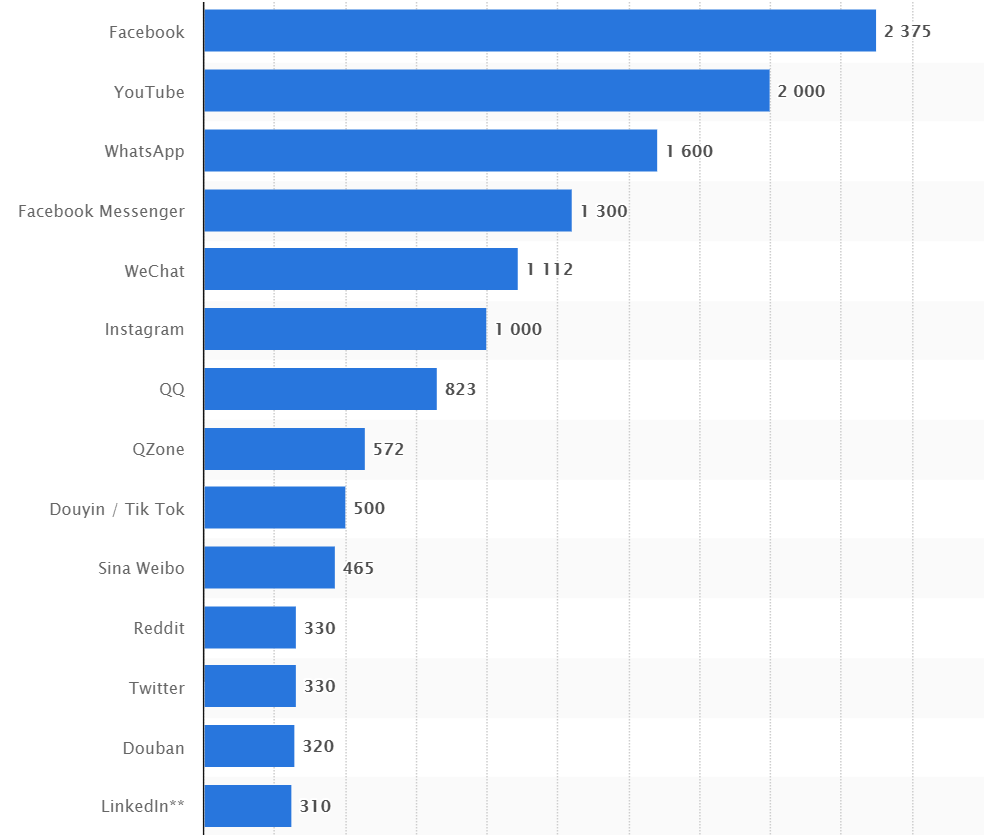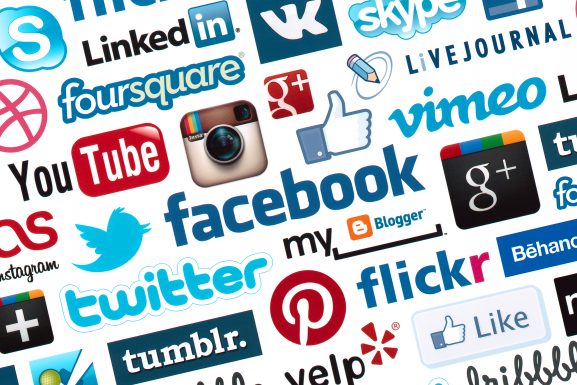Saying that most people spend a good part of their days on social media would not be an exaggeration. Not in today’s world.
Social media has become an integral part of people’s lives and daily routines. Some are addicted to it so much that the first thing they do after waking up is to check their social media feeds.
Given the importance of social media in consumers’ lives, marketers and businesses flock to social platforms in the hope of connecting with their target customers. However, there is a content overload on social media and the competition is very high. It can be extremely difficult for you to stand out unless you have a clear social media marketing strategy.
Staying updated on the latest social media trends can help fuel your strategy and make you stand out in the crowd. Here are top social media trends that you need to be aware of for 2020 and beyond.
Social Media Trend #1 – Ephemeral Content Will Keep Gaining Popularity
Ephemeral content is something that is available only for a short duration and disappears afterwards. Instagram and Snapchat Stories are perfect examples of this type of content.
Today, people’s attention spans are short and the way they like to consume content has also changed. This is why content formats like Stories have become popular. They are short, engaging, and addictive in a way that people can spend hours scrolling through one Story after another.
This is evident by the substantial rise in Instagram Stories’ daily active users, as shown below.
Marketers have taken notice of this trend and will continue to leverage it to their advantage. According to this recent report by Hootsuite, 64% of marketers either already have incorporated Instagram Stories into their strategies or plan to.
Another study suggests that brands post a Story once in four days, again, proving the point that these are getting more and more popular.
Social Media Trend #2 – Niche Social Platforms Will Perform Well
Facebook and Instagram have long dominated social media as the largest and most popular platforms. However, in recent years, several other niche social media platforms have not only emerged but have significantly risen to fame.
TikTok, for example, is one such platform that started in 2016 and immediately gained popularity among youth. B2B companies prefer LinkedIn for their social media initiatives, while the gaming community flocks to Twitch. There are several such alternative social media platforms that are gaining popularity and will continue doing so in 2020 and beyond.
Here are some of the most popular social media platforms by the number of users or registered accounts.
Social Media Trend #3 – Instagram Will Remove Likes
Instagram is one of the largest social networks and any major changes implemented here can shape the social media landscape. One such major change is the possibility of Instagram removing the likes feature for posts.
Instagram has recently tested this proposal in a beta test and may soon apply this change globally. The logic that it has given is that likes determine a person’s social value and waiting for such validation is detrimental to people’s mental health.
However, there are a lot of people who outright reject the reason and think that Instagram wants to implement this change to earn more. Brands pay enormous sums of money to influencers to promote their products. None of this money goes to Instagram. In fact, influencer marketing has become so popular that brands are moving away from traditional marketing methods like advertising.
If Instagram removes likes then brands won’t be able to measure the direct impact of their campaigns as easily as they do now. This might encourage some brands to invest in Instagram Ads as they can easily track the ROI for those.
A scenario where Instagram successfully removes likes and gets more marketers to move to their ads feature could be transformative for social media marketing. This will not only affect influencers but may also encourage other social networks to make such moves.
Social Media Trend #4 – Social Commerce Will Expand
Social media platforms like Instagram, Pinterest, and Facebook have long been used by brands to sell their products. Social commerce has become a new retail avenue for brands and this trend is only going to get stronger.
Social commerce is well on its way to becoming a mainstream retail channel on par with other mediums like websites and offline stores. This trend will strengthen further with more and more social networks introducing pro-selling features like shoppable posts.
From shoppable posts to Instagram Storefronts, social networks are continuously evolving to become retail platforms. Brands and marketers will leverage these and incorporate social commerce in their sales strategies.
Social Media Trend #5 – Video Content Will Dominate
Video content is one of the most engaging forms of content and will soon dominate the social media a clear winner over all other types of content. Whether it is short-form videos like those popular on TikTok or Stories or long-form content on YouTube, videos are the future of social media content.
According to a Cisco study, by 2022, 82% of all online content will be video content. This clearly shows how important it is to start utilising video content to stay relevant in the social media domain.
If you’re not currently creating videos, it is time that you include it in your content strategy. In the near future, videos will dominate social media and anyone who doesn’t realise that will have a tough time.
You can start by using features like Stories both for your social media content and for advertisements. You can also add videos to your social media posts, even on platforms that were traditionally dominated by image or text content.
Technology Adoption Will Be at an All-Time High
Social media will see a rise in the adoption of technologies like augmented reality (AR) and virtual reality (VR). As these platforms grow, users will demand better and more engaging experiences and these technologies can make that happen.
Facebook is already taking huge steps in this direction with the introduction of Horizon, their social virtual reality world. This is a kind of virtual world where people can connect, play games, and explore. This is the next level of social connection and could very well be the future of social media.
While the adoption of VR in social media might still be at an extremely nascent stage, the same can’t be said for AR. Augmented reality filters are now being used on several major platforms like Snapchat and Instagram. These were introduced as a means to enhance the visual content shared on social media and are widely popular.
Influencer Marketing Will Continue to Soar
Influencer marketing is not a new trend, but it is one that is going to stay for a while. Social media today is dominated by influencers who are getting paid exorbitant amounts to promote brands.
The adoption of this trend can be seen from both perspectives. One can be seen by the sheer rise in the number of influencers on social media. Second can be seen by the increase in marketing spend on influencer marketing by businesses.
Investing in influencers is much cheaper than running paid ad campaigns and yet it delivers good results. Moreover, influencers can help marketers achieve a variety of marketing goals and not just generate leads. These are the two main reasons why it has become so popular and is continuously getting stronger and bolder.
Marketers are not just collaborating with 1-2 influencers now, but are working with a whole network of small, relevant, niche influencers. This kind of influencers get much higher engagement and cost much less. Going forward, more and more marketers will use this strategy and work with multiple smaller influencers instead of one celebrity.
More Regulatory Control and Legal Scrutiny
While there are numerous benefits of social media, there are certain negatives that have come to light in recent years. Data privacy and security are two such issues that have made the headlines for social networks like Facebook.
Social media can be very easily used to gather information about anyone and misuse it. There are allegations that certain social networks even sell their user data to other companies.
In light of this, social networks and regulatory bodies will tighten their norms and put more policies in place. Social media is considered unsafe by many people and it would be in everyone’s best interest to change that. So, be ready for more regulations and restrictions on all platforms.
Higher Adoption of Augmented Reality
Augmented reality enhances our reality by adding digital elements to it and changing the way things actually look. Social media platforms have found interesting use cases for this technology and have started leveraging it in recent years.
Instagram, for example, uses augmented reality for its numerous photo filters. Have you seen those filters that can add makeup to your face or a sunglass or bunny ears? That’s nothing but an application of augmented reality for social media.
This trend, though heavily popularised by Instagram and Snapchat, will be adopted by other social media platforms in the coming years. Facebook, for example, launched AR filters before Instagram, but they got popular later. Facebook is also experimenting with other AR and VR functionalities and will come up with more applications of these technologies in the future.
The applications of AR on social media are not limited to just photo filters to post fun posts and stories. Brands can also leverage augmented reality to provide better shopping experiences to their customers.
Sephora, for example, is a beauty brand that has long used AR to allow their customers to try on makeup before buying. While this capability has been on their mobile app for a long time, they have recently also launched it for Facebook.
Now, users can try on Sephora products via Facebook Messenger, using augmented reality filters. This helps people make better purchase decisions, while also having a unique shopping experience.
Augmented reality can have a lot of potential social media applications for brands. And, this trend will be further driven by social media platforms’ continuous efforts to add more AR functionalities.
Increase in the Use of Social Media for Customer Service
Social media has traditionally been a place for people to connect with their social networks and share photos and videos. However, those days are long gone and social media is now so much more than just that.
It has become a retail platform, a product discovery platform, and now, even a customer service channel. A lot of brands have started recognising social media networks as platforms for delivering customer service.
This transition happened gradually as brands started noticing that a lot of customers try to reach out to them on social media. This may be because of a lack of response on other channels or just because it was a more direct way to reach the brands.
It goes without saying that brands started responding to such messages and directing those customers to the right channels.
Fast-forward a few years, and imagine the number of such interactions growing multifold. It’s not just some one-off cases where customers post their questions or complaints on social media and brands respond. Now, it has become a significant enough customer service channel for brands to recognise it as one.
And, it is one of the most important customer service channels, owing to the massive repercussions of not handling a customer well in front of other users. So, it becomes all the more important for brands to handle these customers well.
Personalisation Will be Paramount
Personalisation is a global consumer trend that has been there for several years now. However, it is still a recent one when it comes to its adoption for social media.
Some might argue that brands can’t exactly personalise their social media content for different consumer segments. True. But, they can still customise their social media ads for as many target segments as they like.
The key aspect where businesses and marketers are leveraging the personalisation trend is in their delivery of social media ads. Social media platforms have started providing advanced targeting and customisation options for marketers. These let you show the right ads to the right people at the right times.
Personalisation has reached a level that these social media platforms now also understand the type of products you like. And, they show you ads for similar products from different brands.
Don’t believe me? Try checking an ad, any ad, on Instagram. Within minutes, you will see ads for similar products all over your feed. The more ads you click on, the better it will understand your online behaviour and preferences. And, the next thing you know, all of your Instagram ads will be personalised and curated to your tastes.
Local Targeting Will Become More Prevalent
Just like local SEO is for local brands who want to get more organic traffic, local targeting is the counterpart for social media. A lot of brands use location-based targeting to reach out to and attract people from a specific geographic location.
One common way in which brands attract a local audience is by geo-tagging their posts and stories. If you add a location to your social media content, it will automatically draw-in a local audience.
Social platforms like Instagram provide the option to search for posts from nearby places or specific locations. If you add locations to your content, it will show up in these search results, helping local people find your brand and content.
Geo-targeting works especially well for promoted posts or tweets as these platforms help you target the right audiences.
For example, if you use the “boost post” option on Facebook, you can also select the locations that you want to target. Facebook will show your posts to users in those locations.
Brands can also use geo-targeting to get more people to attend their local conferences and brand events. Or, they can use location filters in their social media ads, to advertise only to a relevant, local audience.
There are a lot of benefits of location-based targeting on social media and you simply need to know how to leverage it.
More Brands Will Incorporate Social Listening into Their Strategies
Social media is a goldmine for data and insights that businesses can use to refine their social strategies. And, with the launch of so many social listening tools, it has become very easy for anyone to access these insights.
Given the ease with which you can tap into social conversations to draw meaningful insights, social listening has made its way into every marketer’s strategy. Brands and marketers are using it for a variety of use cases.
From understanding the impact of a social media campaign to understanding how people perceive a brand, you can get a lot of information using social listening. This has made social listening an integral part of most marketers’ social media strategies.
There are a lot of social media listening tools that you can use for this purpose, so start experimenting and find the one that you like best.
User-Generated Content Will Continue to Be Popular
Brands leveraging user-generated content is not a new trend but is a trend that is still going strong and will continue to do so. The only thing that has changed is the rate of adoption, with more and more marketers utilising UGC.
Some brands, like Daniel Wellington, motivate their customers to create content and tag the brand for a chance to get featured on their page. Some, like Olay or Dove, run relevant marketing campaigns that encourage people to submit their entries to be a part of the campaign.
Some brands, like Airbnb, completely rely on user-generated content for their social media content.
No matter how you want to leverage UGC, you should have a place for it in your content mix. User-generated content is free and is considered much more authentic than branded content. It can help your brand seem more trustworthy and can do wonders for your image.
So, if you have never experimented with user-generated content for your social media profiles, it’s time that you start using it.
The Rise of Social Media Communities
While this is not something new, it is definitely something that is becoming more popular now than ever before.
Social media communities are basically social groups that are created by brands to provide a networking platform for their customers. These are usually private groups that like-minded people can join to talk about their shared interests.
Facebook Groups are a brilliant example of such social communities. Many brands utilise such groups to bring all of their existing and prospective customers together and engage with them in a meaningful way. Group members can discuss various topics, share their experiences, and seek solutions to their challenges.
Brands can also utilise their social media communities to launch new products, seek customer feedback, and gain valuable customer insights.
Conclusion
These are some of the trends that will dominate the social media landscape in 2020 and beyond. Leverage these trends to your advantage and stay ahead of your competitors.Social media is a dynamic and competitive space and these trends can help you ace your social media game. So, keep abreast of the latest developments around these themes and use these for your social media initiatives.


